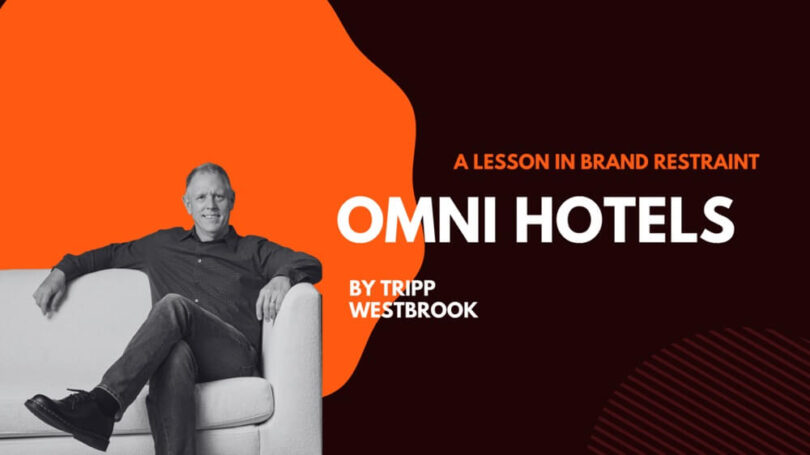“Reverence” is not a term you would typically hear describing a branding approach. When I visited The Homestead in Virginia, I had no idea who the owners were, much less their branding. This is a property that was founded in 1766 and has that Jeffersonian feel of American grandeur and Southern hospitality. It seemed the type of resort that would be independently owned, such is the obvious respect paid to its heritage. Yet, to my surprise, I found out it was part of a hotel chain.
I have seen plenty of campaigns that mistake volume for value. But our job is not to be the loudest — it’s to act as a translator between a brand’s strong beliefs and the needs of consumers. That’s why I am inspired by companies that have the self-awareness to live the axiom of less is more awareness to live the axiom of less is more.
Omni Hotels & Resorts bought the Homestead in 2013 and only recently completed over $170 million in renovations whose goal was to showcase the property’s history, while making it feel like a residence, not a museum. We are talking about spending nearly three years designing the Great Hall’s rug. Now that is reverence. Instead of Omnifying the Homestead, the company displayed admirable restraint.
That is the same quality I urge brands in the acquisition stage to show toward their new properties. Here are some of the principles (and case studies) behind this approach.
Omni: Enhance Identity, Don’t Erase It
While many companies tend to impose their brand heavily on acquisitions, often erasing new properties’ unique identity, Omni honors their history. The rebranded “Omni Homestead Resort” can rightly be called presidential. Its red-brick facade, wrought in the Georgian Revival style, sits in the green fields of the Allegheny Mountains surrounded by a two-acre water park first used as healing springs by Native Americans. It has hosted 24 commanders-in-chief over the years.
Billed as “America’s first resort,” The Homestead is a time capsule of our nation’s history. At the end of the French and Indian War, members of the militia, Captain Thomas Bullitt and Charles and Andrew Lewis, paid 30 shillings for 300 acres of land on which they built an 18-room wooden hotel. After changing hands through the Revolutionary and Civil Wars, railroad executive M.E. Ingalls partnered with J.P. Morgan to transform the lodge into a grand hotel in 1881.

Two centuries of development culminated in the recent renovation, where detailed laser scanning helped preserve every historical detail while updating the landmark resort for a new generation. The design team had five guiding principles: “Traditional, lightness, residential, sophisticated, and iconic.” Today, Omni’s task is to accentuate those values and qualities in its branding and continue to see themselves as stewards, not the developers, of such a rich history.
Bentley: Investment Without Interference
Bentley is synonymous with British luxury engineering, aristocracy, and handcrafted interiors, even in the age of automation. While the film version of James Bond drove Astons, Ian Fleming’s novel progenitor was a Bentley man. When Volkswagen bought out the brand in 1998, there were fears it would tarnish that image and make it, as the Brits say, a bit common.
Previous owners had already dimmed Bentley’s shine. Under Rolls-Royce, it had become a derivative brand. In the 1980s under the now-defunct engineering company Vickers, chronic underfunding held it back. But Volkswagen saw something different: the B-badge and all it stood for was to be preserved.

The German company modernized Bentley’s original factory in the small English town of Crewe and maintained its craftsmanship traditions. They also brought engine production back in-house in an era when BMW was standardizing Rolls-Royce production. Today, all Bentleys are still assembled at the historic Crewe plant.
Instead of subjecting Bentley to the process efficiencies of a mass-vehicle marque, VW became the partner it had needed all along, pouring its resources into upholding the brand’s unique identity.
Burberry: Making Tradition Relevant for New Audience
If both Omni and VW demonstrate how to preserve heritage as a core value, sometimes a brand’s history needs reimagining. As I have written about before in Forbes, Old Spice is an example of where heritage is the problem. But there’s a third approach to history that strikes a balance.
Take the case of Burberry in the early 2000s, by which time its iconic check pattern had begun to be associated with counterfeiters and faux-luxury bad taste. From a branding perspective, there can be a difference between heritage and history — one is timeless and the other anchored to the past. Rather than just reclaiming its image, the fashion house used digital innovation to make tradition relevant for the younger market.

The company that invented the trench coat started creating online communities around its heritage pieces. Its global “Art of the Trench” campaign invited people to share their own trench coat stories and styles on a dedicated platform, turning customers into content creators. Burberry was also among the first luxury houses to livestream its runway shows, and later pioneered the “see now, buy now” feature that broke the old orthodoxy of making consumers wait up to six months for catwalk designs to hit stores.
The Next Chapter
These examples point to a broader truth about brand stewardship: leaning into what has made a brand or a property great in the past does not equate with pure conservatism. As the creative director of the interior design firm that took on The Homestead refurbishment, Liana Hawes Young, told T+L: “This is a multigenerational resort, and there is so much family history here, so it was important for us not to change how people feel in the property, but to help elevate it so it can carry on for another 100 years.”
In other words, finding the right balance between preservation and “progress” is what separates brand stewardship from brand management.
Shout out to the team at Omni Hotels & Resorts for showing such tasteful restraint in preserving the Homestead’s heritage and stewarding its legacy of American hospitality: Kurt Alexander , Jim Caldwell , Trip Riggs , Michael Innocentin , Annette Bales , Vince Parrotta , Jeff Doane , Gustaaf Schrils , Daniel C. Surette.









